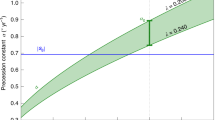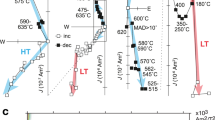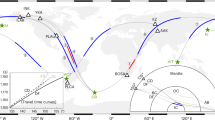Abstract
Many known rocky exoplanets are thought to have been spun down by tidal interactions to a state of synchronous rotation, in which a planet’s period of rotation is equal to that of its orbit around its host star. Investigations into atmospheric and surface processes occurring on such exoplanets thus commonly assume that day and night sides are fixed with respect to the surface over geological timescales. Here we use an analytical model to show that true polar wander—where a planetary body’s spin axis shifts relative to its surface because of changes in mass distribution—can continuously reorient a synchronous rocky exoplanet. As occurs on Earth, we find that even weak mantle convection in a rocky exoplanet can produce density heterogeneities within the mantle sufficient to reorient the planet. Moreover, we show that this reorientation is made very efficient by the slower rotation rate of a synchronous planet when compared with Earth, which limits the stabilizing effect of rotational and tidal deformations. Furthermore, a relatively weak lithosphere limits its ability to support remnant loads and stabilize against reorientation. Although uncertainties exist regarding the mantle and lithospheric evolution of these worlds, we suggest that the axes of smallest and largest moment of inertia of synchronous exoplanets with active mantle convection change continuously over time, but remain closely aligned with the star–planet and orbital axes, respectively.
This is a preview of subscription content, access via your institution
Access options
Access Nature and 54 other Nature Portfolio journals
Get Nature+, our best-value online-access subscription
$29.99 / 30 days
cancel any time
Subscribe to this journal
Receive 12 print issues and online access
$259.00 per year
only $21.58 per issue
Buy this article
- Purchase on Springer Link
- Instant access to full article PDF
Prices may be subject to local taxes which are calculated during checkout




Similar content being viewed by others
References
Dole, S. H. Habitable Planets for Man 1st edn (Blaisdell Pub. Co., New York, 1964).
Leconte, J. et al. 3D climate modeling of close-in land planets: circulation patterns, climate moist bistability, and habitability. Astron. Astrophys.554, A69 (2013).
Menou, K. Water-trapped worlds. Astrophys. J.774, 51 (2013).
Turbet, M. et al. The habitability of Proxima Centauri b. II. Possible climates and observability. Astron. Astrophys.596, A112 (2016).
Wordsworth, R. Atmospheric heat redistribution and collapse on tidally locked rocky planets. Astrophys. J.806, 180 (2015).
Turbet, M., Forget, F., Leconte, J., Charnay, B. & Tobie, G. CO2 condensation is a serious limit to the deglaciation of Earth-like planets. Earth. Planet. Sci. Lett.476, 11–21 (2017).
Haberle, R. M., McKay, C. P., Tyler, D. & Reynolds, R. T. Can synchronously rotating planets support an atmosphere? In Circumstellar Habit. Zones: Proc. 1st Int. Conf (ed. Doyle, L. R.) 29 (Travis House, CA, 1996).
Heng, K. & Kopparla, P. On the stability of super-Earth atmospheres. Astrophys. J.754, 60 (2012).
Walker, J. C. G., Hays, P. B. & Kasting, J. F. A negative feedback mechanism for the long-term stabilization of the earth’s surface temperature. J. Geophys. Res.86, 9776–9782 (1981).
Edson, A. R., Kasting, J. F., Pollard, D., Lee, S. & Bannon, P. R. The carbonate–silicate cycle and CO2/climate feedbacks on tidally locked terrestrial lanets. Astrobiology12, 562–571 (2012).
Kite, E. S., Gaidos, E. & Manga, M. Climate instability on tidally locked exoplanets. Astrophys. J.743, 41 (2011).
Makarov, V. V., Berghea, C. & Efroimsky, M. Dynamical evolution and spin–orbit resonances of potentially hbitable exoplanets: the case of GJ 581d. Astrophys. J.761, 83 (2012).
Leconte, J., Wu, H., Menou, K. & Murray, N. Asynchronous rotation of Earth-mass planets in the habitable zone of lower-mass stars.Science347, 632–635 (2015).
Munk, W. H. & MacDonald, G. J. F. The Rotation of the Earth: A Geophysical Discussion (Cambridge University Press, New York, 1960).
Evans, D. A. D. True polar wander and supercontinents. Tectonophysics362, 303–320 (2003).
Matsuyama, I., Nimmo, F. & Mitrovica, J. X. Planetary reorientation. Annu. Rev. Earth. Planet. Sci.42, 605–634 (2014).
Neron de Surgy, O. & Laskar, J. On the long term evolution of the spin of the Earth. Astron. Astrophys.318, 975–989 (1997).
Goldstein, H., Poole, C. & Safko, J. Classical Mechanics (Addison-Wesley, San Francisco, 2002).
Gold, T. Instability of the Earth’s axis of rotation. Nature175, 526–529 (1955).
Matsuyama, I. & Nimmo, F. Rotational stability of tidally deformed planetary bodies. J. Geophys. Res. Planets112, E11003 (2007).
Tsai, V. C. & Stevenson, D. J. Theoretical constraints on true polar wander. J. Geophys. Res. Solid Earth112, B05415 (2007).
Hager, B. H., Clayton, R. W., Richards, M. A., Comer, R. P. & Dziewonski, A. M. Lower mantle heterogeneity, dynamic topography and the geoid.Nature313, 541–545 (1985).
Zhong, S., Zhang, N., Li, Z.-X. & Roberts, J. H. Supercontinent cycles, true polar wander, and very long-wavelength mantle convection. Earth. Planet. Sci. Lett.261, 551–564 (2007).
Gurnis, M. Large-scale mantle convection and the aggregation and dispersal of supercontinents. Nature332, 695–699 (1988).
Rogers, L. A. Most 1.6 Earth-radius planets are not rocky.Astrophys. J.801, 41 (2015).
Willemann, R. J. Reorientation of planets with elastic lithospheres. Icarus60, 701–709 (1984).
Daradich, A. et al. Equilibrium rotational stability and figure of Mars. Icarus194, 463–475 (2008).
Turcotte, D. L., Willemann, R. J., Haxby, W. F. & Norberry, J. Role of membrane stresses in the support of planetary topography. J. Geophys. Res.86, 3951–3959 (1981).
Willemann, R. J. & Turcotte, D. L. Support of topographic and other loads on the moon and on the terrestrial planets. In Lunar Planet. Sci. Conf. Proc. Vol. 12 (eds Merrill, R. B. & Ridings, R.) 837–851 (Pergamon, New York, 1982).
Monin, A. S. Planetary evolution and global tectonics. Tectonophysics199, 149–164 (1991).
Fortney, J. J., Marley, M. S. & Barnes, J. W. Planetary radii across five orders of magnitude in mass and stellar insolation: application to transits. Astrophys. J.659, 1661–1672 (2007).
Goldreich, P. & Soter, S. Q in the solar system. Icarus5, 375–389 (1966).
Mitrovica, J. X. & Forte, A. M. A new inference of mantle viscosity based upon joint inversion of convection and glacial isostatic adjustment data. Earth. Planet. Sci. Lett.225, 177–189 (2004).
Post, R. L. Jr. & Griggs, D. T. The Earth’s mantle: evidence of non-Newtonian flow. Science181, 1242–1244 (1973).
Spada, G., Sabadini, R. & Boschi, E. Long-term rotation and mantle dynamics of the Earth, Mars, and Venus. J. Geophys. Res.101, 2253–2266 (1996).
Sohl, F. & Spohn, T. The interior structure of Mars: implications from SNC meteorites. J. Geophys. Res.102, 1613–1636 (1997).
Moore, W. B., Simon, J. I. & Webb, A. A. G. Heat-pipe planets.Earth. Planet. Sci. Lett.474, 13–19 (2017).
Kankanamge, D. G. J. & Moore, W. B. Heat transport in the Hadean mantle: from heat pipes to plates. Geophys. Res. Lett.43, 3208–3214 (2016).
Acknowledgements
This project has received funding from the European Research Council (ERC) under the European Union’s Horizon 2020 research and innovation programme (grant agreement No. 679030/WHIPLASH). The author thanks E. Couderc, R. Jolivet, L. Londeix and F. Selsis for comments on the initial manuscript.
Author information
Authors and Affiliations
Corresponding author
Ethics declarations
Competing interests
The author declares no competing interests.
Additional information
Publisher’s note: Springer Nature remains neutral with regard to jurisdictional claims in published maps and institutional affiliations.
Supplementary information
Supplementary Information
Supplementary figure and table
Rights and permissions
About this article
Cite this article
Leconte, J. Continuous reorientation of synchronous terrestrial planets due to mantle convection. Nature Geosci 11, 168–172 (2018). https://doi.org/10.1038/s41561-018-0071-2
Received:
Accepted:
Published:
Issue Date:
DOI: https://doi.org/10.1038/s41561-018-0071-2
This article is cited by
-
Ariel planetary interiors White Paper
Experimental Astronomy (2022)



